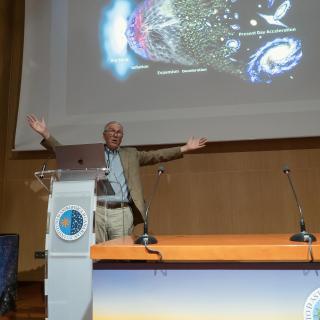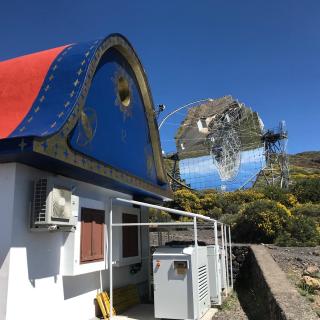The GTC (Gran Telescopio CANARIAS) is an optical-infrared telescope of 10.4m diameter on the Island of La Palma (Canary Islands). It is a general purpose telescope and was designed to cover many different fields of astronomical research, so the science it produces is diverse. "Science with the GTC" is not a conference of specialists in one field, but an interchange of information about the science which can be moved forward with the telescope and an exposition of the main scientific results achieved with it. We will talk about some of them.
Guo Chen (Instituto de Astrofísica de Canarias, IAC) was the first astrophysicist to make his presentation. He explained that when a planet passes in front of a star, its apparent radius can apparently change according to the observed wavelength, which allows us to trace its atmospheric composition. To do that we use a technique called transmission spectroscopy, which is being used to monitor several types of exoplanets. The large light gathering power of the GTC allows observers to achieve high photometric accuracy, (necessary to measure such weak signals) and as a result they have found that the atmospheres of exoplanets come in more than one variety. They can be partly "transparent" and show sodium absorption, or blurred via Rayleigh scattering, or even very cloudy, without specific spectral features.
Does anyone know how a star falls into a black hole? Stars orbit around these with very short period orbits, of a few hours. So in one night's observing on the GTC you can observe more than one orbital cycle, several orbits of the star around the black hole. Jonay González-Hernández (IAC) studied this remarkable phenomenon with this telescope as well as with the Keck and the VLT (Very Large Telescope) and found that the stars fall towards the black hole more quickly than predicted. Since he published his results the theoretical physicists have another problem to solve...
Nicolas Lodieu (IAC) presented "the coolest brown dwarfs known today". This could be understood also in the metaphorical sense of the word "cool". Brown dwarfs are very cool objects, at less than 500 K, and have very low luminosities (for a given distance, the colder the less bright they appear). These brown dwarfs were observed using spectroscopy and photometry (imaging), with the OSIRIS instrument on the GTC. The large size of the telescope is important for studying these objects. Thanks to its large aperture the observations are of better quality (better signal to noise ratio) that those on smaller telescopes. The Hubble Space Telescope, in the near infrared, and the WISE satellite, in the middle infrared, were used to discover these objects, because they are brightest in these wavelength ranges. The GTC gave complementary information to these space observations, in the optical range. Lodieu was the first author on the first scientific article using observations with this telescope, published in 2010.
An object discovered in a distant galaxy could be a supernova. Or is it? This story was told by Christina Thöne (Instituto de Astrofísica de Andalucía, IAA) who explained that it was the second case of an enormous eruption on a massive star. At first it was sufficiently bright to observe in the optical wavelength range with a small telescope, and the observers did so. But for spectroscopy they needed the GTC, and specifically OSIRIS. When months after the eruption, the object faded, the GTC was needed even to see it in the optical. The telescope turned out to be valuable to study the environment of the galaxy, where three supernovas are situated, (these are genuine).
A global network of robotic telescopes found a very strange object last January, similar to V838 Monocerotis, in the Andromeda galaxy. It was then observed with two metre class telescopes to obtain spectra and photometry. It was not a classical nova. In order to find out more about it GTC time was requested, to perform high resolution spectrscopy with OSIRIS. Peter Pessev (IAC), a GTC support astronomer, told us that only eight objects of this kind have been found, and they are normally explained as the result of two stars merging. To compare, we know thousands of supernovae and novae. The time between the discovery of this object and the previous similar object was 25 years, which agrees with the predictions of theoretical models for a galaxy such as Andromeda.
These are some of the studies presented during the first day dealing with astrophysics. The day began with some words from Alberto Carramiñana, Director General of the INAOE (Instituto Nacional de Astrofísica, Óptica y Electrónica), from Ygnacio Martínez, vice-chancellor of Research and Postgraduate Studies at the Benemérita Universidad de Puebla, and Elena Terlevich, an astrophysicist at the INAOE and the chair of the meeting. Terlevich commented that the researchers are "Very happy with the results which the GTC is producing" and mentioned that "there are more than 200 published scientific articles with results from this telescope" so that "the programme of presentations is very dense". Tomorrow more.
The V International Conference "Science with the GTC" is organized by the Instituto Nacional de Astrofísica, Óptica y Electrónica de México (INAOE) and the Instituto de Astronomía of the Universidad Nacional Autónoma de México (IA-UNAM), with participation by the Instituto de Astrofísica de Canarias (IAC) and the University of Florida (UF).
The GTC is the result of an international collaboration between Spain (IAC), Mexico (IA-UNAM and INAOE) and the United States (UF).
Annia Domènech
More information
Website of the V International Conference “Science with GTC”
The 5th International Conference on “Science with the GTC” starts tomorrow
Press contact:
Annia Domènech
annia [at] iac.es (annia[at]iac[dot]es)



